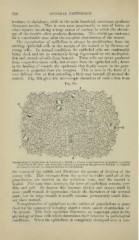Page 698 - My FlipBook
P. 698
GENERAL PA THOL G Y.
tendency to shrinkage, while in the main beneficial, sometimes produces
disastrous results. This is seen most prominently in case of burns or
other injuries involving a large extent of surface, in which the shrink-
age of the cicatrix often produces distortion. This shrinkage continues
for a considerable time after the complete cicatrization of the wound.
The reproduction of epithelium is always by proliferation from the
existing epithelial cells at the margin of the wound or by division of
young cells. In normal conditions the epithelial cells are continually
being shed, and are as constantly being regenerated by the multiplica-
tion and growth of cells from beneath. These cells are never produced
from connective-tissue cells, but always from the epithelial cell ; hence
in the healing of wounds the epidermis that finally covers in the gran-
ulations is projected from the margins. This is seen in the form of a
very delicate film at first extending a little way inward all around the
wound. Fig. 398 gives the microscopic characters of such a film froiu
Fig. 398.
Regeneration of Epithelium in Cornea of a Rabbit- i. fibioub tian^foiniation of nuelens; fi, partial
separation of the hbres and hour-fjlass change of nucleus in the process ol division: c, complete
divi^sion of nucleus; (/, complete division of cell (Eberth).
the cornea of the rabbit, and illustrates the process of division of the
young cells. This increases from day to day in width until all of the
granulations are covered in, the secretions cease, and the wound is
healed. For some time, however, the layer of epithelium remains very
thin and soft. By degrees this becomes thicker and denser, until in
most small wounds it approac-hes closely the characters of the normal
})arts, but in large wounds it usually remains permanently much thin-
ner than normal.
Tranxphntfifion of epithelium to the surface of granulations is prac-
tised for the ])urpose of l)ringing about a more speedy cicatrization of
the wound. This little operation illustrates an important point in the
]ihvsiology of these cells which determines their behavior in pathological
conditions. When the epithelium is completely destroyed over a con-


